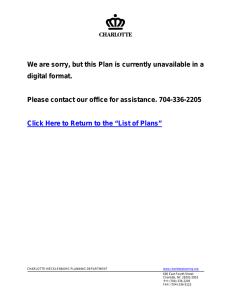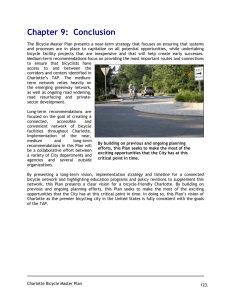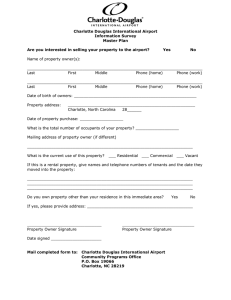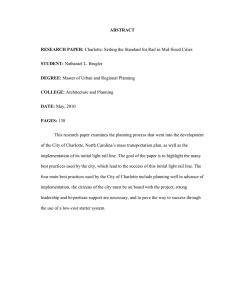TRANSPORTATION Action Plan 2014 Annual Report The City of Charlotte
advertisement
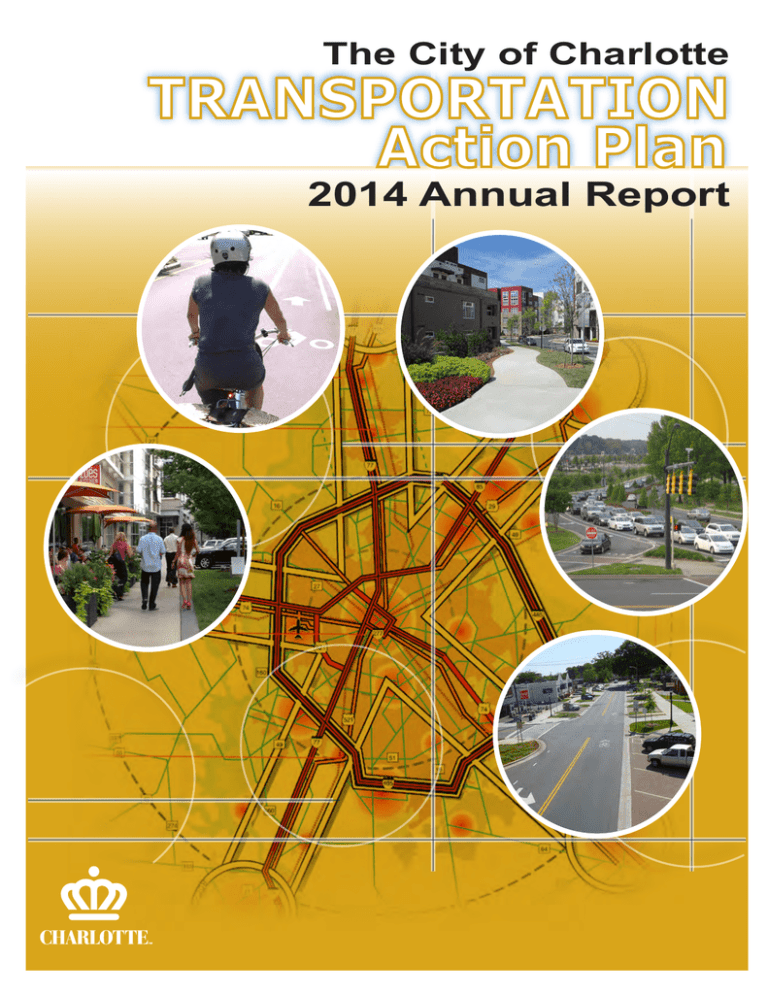
The City of Charlotte TRANSPORTATION Action Plan 2014 Annual Report I n May of 2006, the Charlotte City Council adopted the Transportation Action Plan (TAP) — the City’s first comprehensive, multi-modal, long-range transportation plan. This plan was updated and affirmed by City Council in August of 2011. The TAP describes the City’s policies, projects and programs that will be necessary over the next 25 years to accommodate projected growth and reduce existing transportation deficiencies. The next update of the TAP is due in 2016. The TAP Update called for a 25-year investment of $2.6 billion in 2011 dollars to build and maintain a network of local thoroughfares, streets, connectivity projects, traffic signal systems, pedestrian pathways and bicycle facilities. In the coming year, the City will review and update its transportation needs through the process of creating the 2016 TAP update. The demands on the City’s transportation system continue to grow and evolve. Increases in the various types of multi-modal transportation capacity defined in the TAP, in conjunction with increases in freeway and expressway capacities, will be necessary as Charlotte is expected to grow to over one million in population by 2035. I am pleased to present the 2014 Annual Report for the Transportation Action Plan. This report describes the achievements and the challenges that occurred in 2014, our ninth year of implementing the goals, strategies and projects recommended in the TAP. I believe an annual report is important not just to highlight our successes, but also to identify possible changes in strategies or investments that we should consider in the upcoming years. Council and staff have been implementing the TAP’s policies and programs since its adoption. Most recently, the voters’ approval of a new CIP package in 2014 will advance many objectives of the TAP. In the years ahead, City Council will continue to make difficult decisions about transportation priorities, revenues and growth management so that Charlotte can continue to be one of the most livable and economically attractive large cities in the nation. Ron Carlee, City Manager December 2014 Transportation Action Plan 2014 Annual Report T he Transportation Action Plan (TAP) describes the goals, objectives and policies that are necessary to make Charlotte one of the premier cities in the nation for providing land use and transportation choices. A full copy of the Transportation Action Plan is available at http://cdot.charmeck.org. To achieve the City’s goals, the TAP recommends a variety of transportation investments. The cost of these investments is estimated at $2.6 billion for construction and maintenance during the next 25 years. This level of investment—together with concurrent investments in State-maintained freeways and expressways and rapid transit lines—will be necessary to accommodate the City’s ongoing growth, while protecting the high quality of life in Charlotte. Each year’s Annual Report describes the progress and challenges in implementing the TAP. These annual reviews enable City Council and staff to identify obstacles that must be overcome and determine changes in the resources or actions necessary to achieve the City’s transportation-related goals. Among the highlights in 2014: The City began advanced planning work for projects and areas identified in the new Community Investment Plan. This planning work will allow some projects to quickly advance to the design phase following the approval of the city bonds in November. The draft Transportation Improvement Program (TIP) prepared by the North Carolina Department of Transportation for FY2016-2025 includes managed lanes projects on I-77 North and South, I-485 South and US-74 East. Construction of Phase 1 of the City LYNX Gold Line is underway. Operation is scheduled to begin in 2015. LYNX Blue Line Extension (BLE) construction started in July. Operation is scheduled to begin in 2017. Implementation of the Urban Street Design Guidelines (USDG) continued in Capital Improvement Plan projects, area plans, street maintenance activities and through development ordinances. Some recently-completed project examples include the Freedom Drive widening, Tyvola Road lane re-configuration, and the Eastway-Sheffield neighborhood improvement projects. TAP GOAL 1 Continue implementation of the Centers, Corridors & Wedges Growth Framework Achievements The Centers, Corridors and Wedges Growth Framework, adopted in 2010, provides the overarching growth framework for the city. Table A Percentage of Development Locating Within Centers and Corridors TARGET FY 2013 TAP Policy 1.1.2 Total New Households 40% 61.3% New Multi-Family Households 70% 80.9% Total New Office Development 75% 88.6% New Employment 75% 63.3% TAP Policy 1.1.3 The TAP Update, adopted in 2011, supports the City’s growth framework by identifying transportation policies and infrastructure investments appropriate for Centers, Corridors and Wedges. A consultant completed a general assessment of the City’s Zoning Ordinance and identified ordinance options to better support the City’s growth framework and area plans. In FY14, the City met the office, employment, and multi-family targets for centers and corridors (Table A). Current Activities Plans are underway for these areas: • Prosperity Hucks • University City An area plan and land use policy assessment was completed in July, and recommendations are being reviewed for best implementation strategies. A new study of the LYNX Silver Line was initiated in October 2013. This study will update the alignment and technology/mode to be implemented in the Southeast Corridor. TRANSPORTATION ACTION PLAN 2 2014 ANNUAL REPORT The LYNX Blue Line Extension is under construction and will provide light rail service from Uptown to the University of North Carolina at Charlotte. When complete, this service will provide a consistent commute option along the congested I-85/US-29 corridor. Development along the South Corridor totals $1.45 billion. The LYNX Blue Line carries 15,000 riders per day. The City seeks to create more walkable nieghborhoods and provide “car-light” lifestyle options. Some activity centers and parts of corridors, such as South End, have emerged as walkable, mixed-use nodes. However, many wedge areas face significant obstacles in creating a comfortable walking environment. TAP GOAL 2 Prioritize, design, construct and maintain convenient and efficient transportation facilities to improve safety and neighborhood livability, foster economic development, promote transportation choices and meet land use objectives. Achievements Ongoing implementation of the TAP and Urban Street Design Guidelines demonstrates Charlotte’s commitment to creating a multi-modal transportation network with benefits for motorists, pedestrians, bicyclists, transit riders, employers or business owners, and neighborhood residents. During FY14 CDOT designed and/or implemented: • • • • • The City and County have implemented over 180 miles of bicycle lanes, trails, and signed routes in Charlotte, of which approximately 135 miles are on-road facilities. Charlotte is designated as a bronzelevel Walk Friendly Community and bronze-level Bicycle Friendly Community. 1.7 miles of street projects 1 intersection project 12.7 miles of sidewalk projects 12.5 miles of bicycle projects Re-timing of 250 traffic signals Nine pedestrian refuge islands and three pedestrian hybrid beacons were scheduled for implementation throughout the city. Current Activities Over the next four years, CDOT expects to plan, design, and/or construct: • • • • • • 25 miles of sidewalk 40+ pedestrian crossings 40 miles of bicycle projects Re-time 300 traffic signals At least 4 major road projects 2 bridges across I-85 TRANSPORTATION ACTION PLAN 4 2014 ANNUAL REPORT Issues and Challenges While Charlotte has made great strides in creating better streets for all users, there were eight pedestrian fatalities and one bicyclist fatality in FY 2014. Using Urban Circulator Grant funds from the Federal Transit Administration, the City began construction of the 1.5 mile Streetcar Starter Project along Trade Street/Elizabeth Avenue from the Time Warner Cable Arena to Novant Health (Presbyterian) Medical Center. Construction is scheduled to finish in 2015. TAP GOAL 3 Collaborate with local and regional partners on land use, transportation and air quality to enhance environmental quality and promote long-term regional sustainability. Achievements The City supported the Charlotte Regional Transportation Planning Organization (CRTPO) by providing assistance for developing the 2040 Metropolitan Transportation Plan. The City is also working with CRTPO to develop its first Comprehensive Transportation Plan (CTP). Issues and Challenges The successful integration of NCDOT’s Complete Streets Policy into ongoing practice is important to ensure that NCDOT’s project designs reflect urban transportation goals in Charlotte and other cities in North Carolina. The City assisted the Charlotte B-Cycle” bike share system with a system expansion that added four new stations, bringing the total to 24 stations. Current Activities Planning and design are ongoing for projects that will form a network of High Occupancy Toll (HOT) or Express Toll lanes along I-77, I-485, and US-74. In 2014, NCDOT prepared a Traffic and Revenue Study for the US-74 East Corridor and is working on a similar study for I-485. The North Corridor Commuter Rail Project (the Red Line) would provide service between Charlotte and Mooresville — a distance of 25 miles. The Red Line Task Force received a white paper created by NCDOT and CATS that overviews the project and the challenges it faces in light of a passenger rail policy change from Norfolk-Southern Railroad. TRANSPORTATION ACTION PLAN 6 2014 ANNUAL REPORT The City and Centralina Council of Governments are finalizing the recommendations of CONNECT Our Future, a three-year effort to create a Regional Development Framework. The City is coordinating with the NCDOT Rail Division on railroad projects in order to help implement the Southeast High Speed Rail passenger service. These projects include the North Carolina Railroad (NCRR) Double Track Project, the Sugar Creek Road Rail Bridge (in northeast Charlotte), and the Locomotive and Railcar Maintenance Facility (near uptown). The City is working with NCDOT to design a split-diamond interchange as part of the I-485 project through northeast Charlotte. The project includes three parallel streets and six roundabouts. The innovative design is intended to help fulfill the vision established in the Prosperity Villages Plan (1999). Construction is nearly complete. TAP GOAL 4 Communicate land use and transportation objectives and services to key stakeholders. Achievements Through the update of the TAP in 2011, the City re-emphasized its comprehensive set of transportation-related strategies. CDOT sponsors a biennial survey to assess the community’s opinions on transportation issues and concerns, last completed in 2014. The City conducted over 20 pop-up meetings at various community events to inform the public about the Cross Charlotte Trail. This proposed bond project would create a 26-mile multiuse trail across the city. Current Activities The City is tracking land development permits monthly and annually to monitor the Centers, Corridors and Wedges growth targets. That information is available to elected officials, staff and citizens to determine how well the City is meeting specific land use targets. City staff are receiving Community Engagement training that encourages effective and meaningful public participation as part of the City’s new Community Investment Plan. TRANSPORTATION ACTION PLAN 8 2014 ANNUAL REPORT In the Fall of 2014, the City, the Knight Foundation, and Charlotte Center City Partners hosted community conversations about the state of bicycling in Charlotte. As part of the City’s Neighborhood Leadership Awards, CDOT developed and awarded a “Moving Charlotte Forward” award. In 2014 the award recognized the Plaza-Midwood neighborhood for its work promoting transportation choices. Issues and Challenges Successfully integrating land use and transportation decisions over time requires implementing the City’s growth framework including continued communication about the impact of various development scenarios on the City’s fiscal health and service demands. The City’s new Community Investment Plan (CIP) is designed to provide a holistic approach that leverages public infrastructure with private investments. The overall goal of the CIP is to invest in projects that benefit the entire community in the following ways: • Create jobs and grow the tax base • Leverage public and private investment • Enhance public safety • Enhance transportation choices and mobility • Ensure housing diversity • Providing integrated neighborhood improvements The Cross Charlotte Trail will extend a multi-use trail north and south of the existing Little Sugar Creek Greenway for a total of 26 miles. TAP GOAL 5 Seek financial resources, external grants and funding partnerships necessary to implement transportation programs and services. Achievements When City Council updated the TAP in 2011, they acknowledged that the TAP recommended spending $2.6 billion to build, operate and maintain locally funded transportation projects through 2035. CATS received an $18 million competitive grant from the FTA to fund the $22.5 million LYNX Blue Line Capacity Expansion Project (BLCE). The BLCE Project will lengthen the platforms of four existing stations to accommodate three-car trains and upgrade the power supply for extra trains. Federal and State funds have been appropriated to the LYNX Blue Line Extension project. The federal government will fund up to 50% of the total project cost and the State will fund 25%. The construction of I-485 in northeast Charlotte will complete the final section between I-85 and NC-115. The City worked closely with NCDOT to secure funding to help advance the widening of I-485 to the south as well as the completion of I-485 to the north. Current Activities The TAP assumes that Charlotte will fund approximately $100 million a year in transportation improvements. The Community Investment Plan will address some of the City’s transportation needs, but truly implementing the TAP will require a combination of transportation revenue sources similar to these identified by the Committee of 21. TRANSPORTATION ACTION PLAN 10 2014 ANNUAL REPORT The 2016 update to the TAP will review and update the City’s transportation needs and policies as well as revisit the funding required for full implementation. TAP GOAL 5 The Committee of 21, was appointed by the Charlotte Chamber, City of Charlotte, and Mecklenburg County in 2008 to review local transportation needs. The committee recommended an additional vehicle registration fee to be used for roadway maintenance and an additional half-cent sales tax to be used for construction of state and local roadways in Mecklenburg County. The Committee also recommended charging tolls on freeways and applying a Vehicle Miles of Travel Fee. New local-option revenues have not yet been advanced at the state level. Transportation Revenue Sources Recommended Funding Source by The Committee Requires Legislative Approval of 21 To Be Used For Vehicle Registration Fee State Maintenance Half-Cent Sales Tax State Construction Toll Interstates State & Federal Construction and Maintenance Vehicle Miles of Travel Fee State & Federal Construction and Maintenance Source: Derived from http://www.charmeck.org/Committeeof21/home.html Issues and Challenges Federal and state gas taxes continue to diminish as viable transportation funding sources due to a leveling in vehicle-miles travelled and more fuel-efficient vehicles. CRTPO’s 2040 Metropolitan Transportation Plan includes all CDOT-nominated freeway projects, though due to projected funding constraints, was not able to incorporate all thoroughfare projects. North Carolina’s new Strategic Investment law provides funding that will help advance major highway projects such as the widening of I-77 south, US-74, and I-485. At the same time, the new law eliminates state funding for stand-alone bicycle and pedestrian projects. CDOT staff will work with regional partners to determine potential funding sources for these types of projects. The ability of CATS to implement the 2030 Corridor System Plan has been impacted by slow growth in sales tax revenue and lesser availability of federal and state transit funding. TRANSPORTATION ACTION PLAN 2014 ANNUAL REPORT 11 Conclusion T he TAP Annual Report provides an opportunity each year for Charlotte’s residents, elected officials and staff to reflect on our transportation achievements, discuss our transportation challenges and identify better or new ways to meet our transportation goals. Charlotte’s City Council took a crucial first step in addressing the City’s transportation challenges by adopting the 25-year Transportation Action Plan in 2006. City Council then re-affirmed its intent to resolve and overcome ongoing challenges with the adoption of the TAP Update in 2011. The TAP calls for a series of policies, projects and programs that are necessary to accommodate ongoing growth, while protecting our quality of life. This report summarizes the achievements, current activities and challenges the City is now facing as Council and staff continue to implement the TAP in 2015. There have been many achievements since 2006 but there also are significant challenges to meeting the City’s transportation goals. Charlotte is fortunate to be experiencing continued employment and population growth, yet this growth also will ensure that Charlotte’s transportation challenges will not fade away. Looking ahead, four challenges are facing the City Council: 1. Effectively revising the City’s zoning ordinance to help ensure that Charlotte grows in a manner consistent with the Centers, Corridors and Wedges growth framework. 2. Evaluating and selecting permanent and reliable funding sources for transportation, which can be discussed further in the 5-year update of the Transportation Action Plan. 3. Coordinating capital investments with private development opportunities to promote a development pattern that enhances transportation choices, creates public and private value, and allows the City to deliver efficient public services. 4.Continuing to create a safe, walkable, livable public realm that contributes to the quality of life and economic competitiveness of Charlotte. 5 I-8 4 e ut 7 I-7 85 I-4 Center City Mixed Use Activity Center Industrial Center lvd eB nc de en ep Ind Ro Growth Corridor Wedge Other Jurisdiction Charlotte-Mecklenburg Planning Department, May 2013 The Centers, Corridors and Wedges Map (adopted as part of the Transportation Action Plan) helps provide the framework for land use and transportation investment decisions in Charlotte. ¯ Figure 2 - Transportation Projects Programmed or Implemented By the City Since TAP Adoption O ld S Ch ur ch Rd i el s tf dR d Ridg e R d d Alexa nder ana R d e k Rd Cr e St yo n Tr Rd eal N d r Rd R d o d Rd R Ro ck Rd Dro n fe re Rd Bla ir s r Hi 218 int tt h ew s -M am 8 Ma ! N. N o rt N ew ell Rd c e Rd en R and er d l ex wy od llw o Fu Rd Jo h n Ln St Rd s i l li p Ph A h S am O ld Pr o l Rd me Ca r Rd isb a rr H . W T Har ri s Blv d nc e d a Rd Ma rg a re tW Ln on S har o n yR iv e r Ch u rc h ur g Ho ty nA mi NS har o re Br W R W. yn w Gr i er R on co C r t wa yD Ea s ek Rd v Rd P ar kS out h Dr P ark Rd 21 k d NC 51 R d s P ea t S Rd South Blvd ive Rd rd Rd W S ugar C ree k Ln ne The Plaz a Av igle Se n s Rd Qu K i ngs Dr Av rth ilw o Fo Na tio ns s r Rd ce Rd rm el Nati on Rd P rovid k Pa r Ca Jo - Pin eville Roc k Hill Rd Rd Pa Uptown Charlotte e w s Rd Rd n El m L Rd ! Ku y ke d n d a ll R § ¨ ¦! mm Co 1 Rd se unity H ou US 52 YO R K o Pr vid d enc e R W B £ ¤ 521 Ar 521 ey ll -Ke ll ley M or ri s M UNION 77 0 Programmed or Implemented Projects Intersection Roadway Charlotte Department of Transportation Charlotte-Mecklenburg Government Center 600 East Fourth Street Charlotte, North Carolina 28202 http://cdot.charmeck.org ¦ ¨ § Rd 160 s r Rd Rd vin £ ¤ dr Far m s Rd ant ry y -K Ar dr e T il ! Rd 49 r s 27 s r ¦ ¨ § 0.5 1 Miles 27 74 r s £ ¤ 277 ar LANCASTER 485 ! e Hy ! C o m mons P k wy Tom S hort R d t er nty ne R Mc Ke e lla Ba 29 £ ¤ 277 d d R L an c as or m an ¦ ¨ § ee Rd McK Weddi ngton Rd r Zo a C a ro li na y Pl ac e P kw Rd rk ill eM at th Rd n st o P inev ence hn Re a rd R d ll R Rd Ne v in St S tatesv il le A v Gra ha m I daho Dr Beatties F or d Rd Av St C am p G reen e Bl vd Ke n Qu een s e Cre t ee l e h Sc ot Al le Dr ield F or d le R da ak O Rd Ho vis B r adfo rd Dr R o ck Rd Little To ddv ille Rd S am W ilson Rd la c Rd Park d ef Bri d Dow n s R d B lv s Fo R i Rd d dR wil e k Rd H e lac al r s Rd ld Dr en Colony R d !! Rea ye fe re Sardis Rd v id C re t in w La H il l s R d K o Pr S te e le e Rd v ro G on a all d eR ce d ton C hurc h i ls -M ve s sion rru s R d W Rd B lv d D ! ar le R em a non Mar gare t n ro Mo s r rl e Rd C aba Alb Leb R d G ! R Sardis Rd e ag l e s le n Rd e ma A lb E le Id olp h on y R u se i ty d vi d in g ho R wR We st a ro Sh n A m 16 Fairvi ew R d S haron Vi ew llo Ho S har on R d W. C ar owi nd s Rd ! ron ha § ¨ ¦ Pe ll a il Qu t d rt R d 485 W d ol l e Dr Stew a C amp d R R and Rd Rd ro ilg W e Rd d 49 R ch hu r 27 d R s r nS n so n C ro v e R d Mi ny m o H eb r o H ic kor y G s r do v er en ar Sh ! ! us e Blv d C l do r d Rd n Ra Rd e d e Ln da dy P d ia r R R un ch Ar S an i ng ho oo dR 24 C n Rd o la s! r t enc ovid Pr l xt Arling hS 7t ph A Se P la z a R d E Rd E ee Rd e nc ld S St St O d St ll t ne Dr 4th wa e N ee l R d St Centr al A v ! St W al th ll St Kilbor 5th St e we e e Plaza Ro b i N l aw Rd R d ro c Sham k D r st E a Rd rd Fo C Arr ow er n lto Mi Av r k wo o d Av w Ha St 6th St 3r on St Do Mc -G r ie r Rd rt St St 7th e St rd n so v id Da d T h e P l a za th 36 ad St ad he re Mo k ar yb o od Tyv Br ow n S on St rd ll St e va Br we ld Ca Tr e Blv d ut le ca W s th e St Ea st d St on on Pa t ! Try St e va Br d R m Rd ! We st T ry ch ll eg Co S B ea S Ol on vids S t Da St n yo St 4th o Shopt on Rd am St ur Ch t ! Ty vo la Tr ld w Ro ck y Th t Ma St ri f Cl an t on R d R m rk Yo W nt t tS Min mo u n So 49 30 t 5th Th d Wes t B lv ah St p lar Po Mi 74 Re d Blv hS v e d Gr £ ¤ £ ¤ 29 d o Av N e ge d n t Rd P ine Oak s D r wn A Rd kR i ty yC Ch . At an Oa kl a erry am P kwy B il l y Gr ah rris s r rsit Ck. § ¨ ¦ Dalton Av tR ac ive Un Ca Rd Rd d Mo ! I B M Dr k ! 85 sF ow N d d Blv nde r l ex a ll ard oll tH M D. A a R B e ll zz St ghan y Rd S h o pt o n R d W . M Ln s Rd Tu c ka se n B l vd Pa d i on B l v Ro D e le y Ash O ld !! Dr Mu lberry C h Rd Wilk i ns o s eegee Rd Fre ed om H os kin B wo od G le n Dr ka Tuc e CABARRUS Ch u ry ic ko ell-H R d New ve Gro 27 rs G ro ve Rd Dr 85 Cind y Grie a ke pe sa Br oo ks h ir k v il n Rd lvd s r hap el R d sC § ¨ ¦ Yor k ib bo Rd Che d R Aute n h ur c l R Ch ol ee htr ac G d kR re e tH Be lmea de Dr Pe 115 rC ga Su d 77 d Cr e e W n B lv d Rd lhave R d R d i s B l vd W Rd d ti es For d R Beat B el un se t H ar r h rc Rd Su n ed Sta te sv il le d ry d Ma l lar WT me k Fer eR 21 lo Sa Oa s elle d al R ozze lles F e rry M £ ¤ § ¨ ¦ r s Rd k ev i e w La le r R nt ers v il l e Rd d Hu y- Fr re oo d ! Bl vd ol R ! ! yC hu hR R m es zz Ro ok sh ire ! y Rd d ho Sc el l Od -O d R ea Br o Mo ce R ! rc V an 16 n J o hn s to er i t P ros p d ne R row H uc k s s r G AS TO N d eh B m Ar De R on ll Rd d y -Hu nt e rs v i l l e R M t Holl Ea P rosper it y Rd M cC oy Rd d Asbu ry Ch a pel R e Rd s vill Beatt ie s sv il le Rd rd Fo Rd e ta t State H am bright 0 1 2 Miles ! 16 r s Charlotte Department of Transportation Planning & Design - GIS October 24, 2014 Rd
